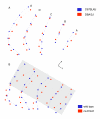Geometric morphometrics defines shape differences in the cortical area map of C57BL/6J and DBA/2J inbred mice
- PMID: 16978410
- PMCID: PMC1578583
- DOI: 10.1186/1471-2202-7-63
Geometric morphometrics defines shape differences in the cortical area map of C57BL/6J and DBA/2J inbred mice
Abstract
Background: We previously described planar areal differences in adult mouse visual, somatosensory, and neocortex that collectively discriminated C57BL/6J and DBA/2J inbred strain identity. Here we use a novel application of established methods of two-dimensional geometric morphometrics to examine shape differences in the cortical area maps of these inbred strains.
Results: We used Procrustes superimposition to align a reliable set of landmarks in the plane of the cortical sheet from tangential sections stained for the cytochrome oxidase enzyme. Procrustes superimposition translates landmark configurations to a common origin, scales them to a common size, and rotates them to minimize an estimate of error. Remaining variation represents shape differences. We compared the variation in shape between C57BL/6J and DBA/2J relative to that within each strain using a permutation test of Goodall's F statistic. Significant differences in shape in the posterior medial barrel subfield (PMBSF), as well as differences in shape across primary sensory areas, characterize the cortical area maps of these common inbred, isogenic strains.
Conclusion: C57BL/6J and DBA/2J have markedly different cortical area maps, in both size and shape. These differences suggest polymorphism in genetic factors underlying cortical specification, even between common isogenic strains. Comparing cortical phenotypes between normally varying inbred mice or between genetically modified mice can identify genetic contributions to cortical specification. Geometric morphometric analysis of shape represents an additional quantitative tool for the study of cortical development, regardless of whether it is studied from phenotype to gene or gene to phenotype.
Figures








References
Publication types
MeSH terms
Substances
Grants and funding
LinkOut - more resources
Full Text Sources

